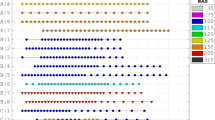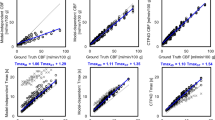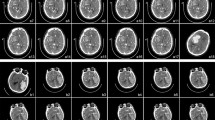Abstract
Purpose
The CT angiography (CTA) spot sign is a strong predictor of hematoma expansion in intracerebral hemorrhage (ICH). However, CTA parameters vary widely across centers and may negatively impact spot sign accuracy in predicting ICH expansion. We developed a CT iodine calibration phantom that was scanned at different institutions in a large multicenter ICH clinical trial to determine the effect of image standardization on spot sign detection and performance.
Methods
A custom phantom containing known concentrations of iodine was designed and scanned using the stroke CT protocol at each institution. Custom software was developed to read the CT volume datasets and calculate the Hounsfield unit as a function of iodine concentration for each phantom scan. CTA images obtained within 8 h from symptom onset were analyzed by two trained readers comparing the calibrated vs. uncalibrated density cutoffs for spot sign identification. ICH expansion was defined as hematoma volume growth >33%.
Results
A total of 90 subjects qualified for the study, of whom 17/83 (20.5%) experienced ICH expansion. The number of spot sign positive scans was higher in the calibrated analysis (67.8 vs 38.9% p < 0.001). All spot signs identified in the non-calibrated analysis remained positive after calibration. Calibrated CTA images had higher sensitivity for ICH expansion (76 vs 52%) but inferior specificity (35 vs 63%) compared with uncalibrated images.
Conclusion
Normalization of CTA images using phantom data is a feasible strategy to obtain consistent image quantification for spot sign analysis across different sites and may improve sensitivity for identification of ICH expansion.


Similar content being viewed by others
References
Demchuk AM, Dowlatshahi D, Rodriguez-Luna D et al (2012) Prediction of haematoma growth and outcome in patients with intracerebral haemorrhage using the CT-angiography spot sign (PREDICT): a prospective observational study. Lancet Neurol 11:307–314
Goldstein JN, Fazen LE, Snider R et al (2007) Contrast extravasation on CT angiography predicts hematoma expansion in intracerebral hemorrhage. Neurology 68:889–894
Brouwers HB, Battey TWK, Musial HH et al (2015) Rate of contrast extravasation on computed tomographic angiography predicts hematoma expansion and mortality in primary intracerebral hemorrhage. Stroke 46:2498–2503
Brouwers HB, Raffeld MR, van Nieuwenhuizen KM et al (2014) CT angiography spot sign in intracerebral hemorrhage predicts active bleeding during surgery. Neurology 83:883–889
Burkhardt J-K, Neidert MC (2017) Stienen MN, et al. Computed tomography angiography spot sign predicts intraprocedural aneurysm rupture in subarachnoid hemorrhage, Acta Neurochir (Wien). doi:10.1007/s00701-016-3072-1
Burkhardt J-K, Neidert MC, Mohme M et al (2016) Initial clinical status and spot sign are associated with intraoperative aneurysm rupture in patients undergoing surgical clipping for aneurysmal subarachnoid hemorrhage. J Neurol Surg a Cent Eur Neurosurg 77:130–138
Wada R, Aviv RI, Fox AJ et al (2007) CT angiography “spot sign” predicts hematoma expansion in acute intracerebral hemorrhage. Stroke 38:1257–1262
Huynh TJ, Demchuk AM, Dowlatshahi D et al (2013) Spot sign number is the most important spot sign characteristic for predicting hematoma expansion using first-pass computed tomography angiography: analysis from the PREDICT study. Stroke 44:972–977
Delgado Almandoz JE, Yoo AJ, Stone MJ et al (2009) Systematic characterization of the computed tomography angiography spot sign in primary intracerebral hemorrhage identifies patients at highest risk for hematoma expansion: the spot sign score. Stroke 40:2994–3000
Morotti A, Romero JM, Jessel MJ et al (2016) Effect of CTA tube current on spot sign detection and accuracy for prediction of intracerebral hemorrhage expansion. AJNR am J Neuroradiol. doi:10.3174/ajnr.A4810
Tsukabe A, Watanabe Y, Tanaka H et al (2014) Prevalence and diagnostic performance of computed tomography angiography spot sign for intracerebral hematoma expansion depend on scan timing. Neuroradiology 56:1039–1045
Goldstein JN, Brouwers HB, Romero J et al (2012) SCORE-IT: the spot sign score in restricting ICH growth─an Atach-II ancillary study. J Vasc Interv Neurol 5:20–25
Qureshi AI, Palesch YY, Barsan WG et al (2016) Intensive blood-pressure lowering in patients with acute cerebral hemorrhage. N Engl J med 375:1033–1043
Qureshi AI, Palesch YY (2011) Antihypertensive treatment of acute cerebral hemorrhage (ATACH) II: design, methods, and rationale. Neurocrit Care 15:559–576
Dowlatshahi D, Brouwers HB, Demchuk AM et al (2016) Predicting intracerebral hemorrhage growth with the spot sign: the effect of onset-to-scan time. Stroke 47:695–700
Morotti A, Goldstein JN (2016) Diagnosis and management of acute intracerebral hemorrhage. Emerg med Clin North am 34:883–899
Brouwers HB, Chang Y, Falcone GJ et al (2014) Predicting hematoma expansion after primary intracerebral hemorrhage. JAMA Neurol 71:158–164
Del Giudice A, D’Amico D, Sobesky J, Wellwood I (2014) Accuracy of the spot sign on computed tomography angiography as a predictor of haematoma enlargement after acute spontaneous intracerebral haemorrhage: a systematic review. Cerebrovasc Dis 37:268–276
Brouwers HB, Goldstein JN, Romero JM, Rosand J (2012) Clinical applications of the computed tomography angiography spot sign in acute intracerebral hemorrhage a review. Stroke 43:3427–3432
Ertl-Wagner BB, Hoffmann R-T, Bruning R et al (2004) Multi-detector row CT angiography of the brain at various kilovoltage settings. Radiology 231:528–535
Waaijer A, Prokop M, Velthuis BK et al (2007) Circle of Willis at CT angiography: dose reduction and image quality—reducing tube voltage and increasing tube current settings. Radiology 242:832–839
Watanabe Y, Tsukabe A, Kunitomi Y et al (2014) Dual-energy CT for detection of contrast enhancement or leakage within high-density haematomas in patients with intracranial haemorrhage. Neuroradiology 56:291–295
Orito K, Hirohata M, Nakamura Y et al (2016) Leakage sign for primary intracerebral hemorrhage a novel predictor of hematoma growth. Stroke 47:958–963
Mayer S a, Brun NC, Begtrup K et al (2008) Efficacy and safety of recombinant activated factor VII for acute intracerebral hemorrhage. N Engl J Med 358:2127–2137
Ciura VA, Brouwers HB, Pizzolato R et al (2014) Spot sign on 90-second delayed computed tomography angiography improves sensitivity for hematoma expansion and mortality: prospective study. Stroke 45:3293–3297
Rodriguez-Luna D, Dowlatshahi D, Aviv RI et al (2014) Venous phase of computed tomography angiography increases spot sign detection, but intracerebral hemorrhage expansion is greater in spot signs detected in arterial phase. Stroke 45:734–739
Chakraborty S, Alhazzaa M, Wasserman JK et al (2014) Dynamic characterization of the CT angiographic “spot sign”. PLoS One 9:e90431
Gupta R, Phan CM, Leidecker C et al (2010) Evaluation of dual-energy CT for differentiating intracerebral hemorrhage from iodinated contrast material staining. Radiology 257:205–211
Author information
Authors and Affiliations
Consortia
Corresponding author
Ethics declarations
Funding
This study was funded by the following award from the National Institute of Neurological Disorders and Stroke: R01NS073344.
Conflict of interest
JR receives research funding from the NIH. JG receives research funding from the NIH, Boehringer Ingelheim, Pfizer and Portola, and consults for Bristol Myers Squibb. TAB receives funding from the NIH, the Minnesota State and Spinal Cord Injury and Traumatic Brain Injury Grant and Vertex Pharmaceuticals. CL receives research funding from the NIH.
Ethical approval
All procedures performed in studies involving human participants were in accordance with the ethical standards of the institutional and/or national research committee and with the 1964 Helsinki declaration and its later amendments or comparable ethical standards.
Informed consent
Informed consent was obtained from all individual participants included in the study.
Rights and permissions
About this article
Cite this article
Morotti, A., Romero, J.M., Jessel, M.J. et al. Phantom-based standardization of CT angiography images for spot sign detection. Neuroradiology 59, 839–844 (2017). https://doi.org/10.1007/s00234-017-1857-4
Received:
Accepted:
Published:
Issue Date:
DOI: https://doi.org/10.1007/s00234-017-1857-4




